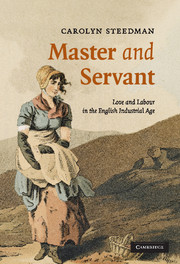Book contents
- Frontmatter
- Contents
- List of maps
- Acknowledgements
- Map 1 Map of the Haworth, Slaithwaite, Huddersfield and Halifax region, 1795
- Map 2 Sketch map of the woollen and worsted producing areas of the West Riding, late eighteenth century
- Prologue
- 1 Introduction: on service and silences
- 2 Wool, worsted and the working class: myths of origin
- 3 Lives and writing
- 4 Labour
- 5 Working for a living
- 6 Teaching
- 7 Relations
- 8 The Gods
- 9 Love
- 10 Nelly's version
- 11 Conclusion: Phoebe in Arcadia
- Bibliography
- Index
1 - Introduction: on service and silences
Published online by Cambridge University Press: 06 January 2010
- Frontmatter
- Contents
- List of maps
- Acknowledgements
- Map 1 Map of the Haworth, Slaithwaite, Huddersfield and Halifax region, 1795
- Map 2 Sketch map of the woollen and worsted producing areas of the West Riding, late eighteenth century
- Prologue
- 1 Introduction: on service and silences
- 2 Wool, worsted and the working class: myths of origin
- 3 Lives and writing
- 4 Labour
- 5 Working for a living
- 6 Teaching
- 7 Relations
- 8 The Gods
- 9 Love
- 10 Nelly's version
- 11 Conclusion: Phoebe in Arcadia
- Bibliography
- Index
Summary
Phoebe Beatson has no voice in Murgatroyd's journal (though she is as much a presence in it as she was in his life). Neither could she write. She was thus in no position to pen the extraordinary (and published) social commentaries and satires that we continue to discover eighteenth-century maidservants producing. She appeared before several magistrates when she was examined as to the state of her settlement and asked to name the father of her unborn child in the early summer of 1802, but any record of her time in a justicing room is quite lost. Neither she nor John Murgatroyd ever turned to a local magistrate to test the limits of the service contract (the hiring agreement) or to complain about its breach by one or the other. So in Phoebe Beatson's case there is no startling, immediate, voice speaking out of a justice's notebook, as does Mary Cant's from Nottinghamshire, in autumn 1785, telling Sir Gervase Clifton, J P that her master has treated her very ill, hit her round the head, and all because when he told her to dress the baby, she had said, ‘He might dress it him self for she was busy’.
Many social historians of the eighteenth and early nineteenth century in England have faltered at the silence of the female domestic servant and found a solution by simply leaving her out of account.
- Type
- Chapter
- Information
- Master and ServantLove and Labour in the English Industrial Age, pp. 13 - 28Publisher: Cambridge University PressPrint publication year: 2007



